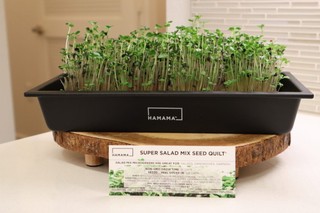Hamama microgreen kit review: How it works and real grow results

Growing microgreens at home is a sustainable way to supplement your diet with greens much higher in nutrients than their mature counterparts.(1) But for many growing them at home is a difficult task. Thankfully, microgreen kits take the guesswork out of growing these potent greens, and leading the way is Hamama.
According to Hamama, broccoli microgreens would require 158-236 times less water than it takes to grow a nutritionally equivalent amount of mature broccoli in the fields of California’s Central Valley in 93-95% less time and without the need for fertilizer, pesticides, or energy-demanding transport farm to table.(2) Combine that with the fact that growing at home eliminates the need for food to travel to the grocery store, and what you have is an environmentally-friendly superfood source.
After hearing about Hamama, we immediately ordered a kit for herbsathome.co (yes, we actually bought it with our money!) and put it to the test! Read on for our full review of this microgreen kit, tips we learned along the way, and the yield we got from each seed quilt.
What is the Hamama microgreen kit?
The Hamama microgreen kit is a hydroponic system designed by two MIT grads to make growing your own microgreens at home super easy. It consists of a pre-packaged, fully-contained system that you just add water to and start growing. What’s more, Hamama offers a monthly subscription that makes it possible to grow a variety of micro greens continuously, year-round.
What is included in the kit?
Each growing kit comes with a reusable grow tray made from recycled plastic, a riser that keeps the seed quilt above the water line, three seed quilts, and instructions on growing. You can purchase a sleek, bamboo frame separately if you want to elevate the aesthetic a bit.
What is a Seed Quilt?
This is the ingenious way that Hamama has devised to distribute just the right number of seeds in a tray for reliable, optimum results. The quilt is basically a coconut coir sheet “sandwich” with evenly spaced, seed and grow medium filled pods between the sheets, all held together by some sort of adhesive. The system works by ensuring consistent moisture in a controlled environment.

The enthusiast's guide to herbs
We’re proud to present our new e-book, The Enthusiast’s Guide to Herbs! Learn everything you need to know about growing and caring for herbs indoors, including in-depth info cards for the 35 most commonly grown herbs.
Click the link below to find out more!
What types of microgreens are available?
One of the best parts of this system is that there is a wide variety of options available, making it feasible to experiment with different greens and mixes. Most of the options available are organic, marked below with a **.
- super salad mix
- zesty salad mix
- hearty broccoli **
- refreshing cabbage
- energizing kale**
- spicy daikon radish**
- sweet wheatgrass**
- earthy clover**
- fragrant fenugreek**
For our kit, we picked: the super salad mix, the zesty salad mix, and hearty broccoli.
If you’re looking to grow wheatgrass check out our full how-to article.
Worth noting is that different seed quilts have different germination/growth rates. This isn’t a big deal, unless you cut quilts in half to grow two types at a time (some people report doing this). There are also some reports of some varieties of seed quilts having more duds, but this wasn’t our experience.

How it works and instructions
Overall, the instructions are pretty straightforward and the entire process of getting started takes less than 20 minutes. First thing, place the riser inside the tray, next, fill the container up to the fill line with three cups of water, and the last step is to place the seed quilt inside and press down for a minimum of 10 seconds to allow it to begin absorbing water immediately.
We tried different methods for the 3 seed-quilts to try and get a sense of what is most effective.
- For the zesty salad mix we followed the instructions word for word, and it was a mostly successful experience. Herbsathome.co is located in Denver, Colorado and during the summer months it gets very hot and dry. So during this test, we were consistently adding water throughout the 7-10 day growth cycle. Before purchasing this product we joined the Hamama Friends Facebook group, and noticed a lot of other people living in similar climates having the same issue. This led us to slightly change our plans for the 2nd quilt.
- **For the super salad mix** after having some watering issues, we decided to start this quilt off with water levels slightly overfilled. As you can see by the videos and photos shown this ended with odd results. The seeds in this quilt quickly started and some even burst through the cover of the seed quilt. Something that didn’t happen during the growth of the zesty salad mix. After slightly under a week, I decided that it was time to peel the cover off of the quilt, and I was surprised to find that I wasn’t able to do so. The added water had caused the adhesive used in the seed quilt to become bonded to the other materials present. I managed to cut away portions of the cover, but not without damaging some of the microgreens.
- **For the hearty broccoli** we more of less followed the instructions from Hamama, but instead of pressing the seed quilt down into the water for 10 seconds, we held it for around 1 minute.We believe that this contributed to our best harvest of the three.We also made sure to continually add water as needed.
Many people, especially in hotter climates, recommend pressing down on the quilt for several minutes to let the water fully absorb, and also report that three cups of water is not enough to get you all the way to harvest time. We have more to report on that below.
Peeling back the Seed Quilt
Within the first 48 to 72 hours, you should see some signs of germination. The seed pods will begin to visibly swell, and then you should see the little sprouts beginning to push the top layer of the quilt up. As you begin to see the green leaves sprouting through the top layer of the quilt, you’ll want to pull back the top layer of the seed quilt to expose the growing greens.
In some cases, the sprouts will be bursting through the seed quilt covers. As soon as you get some breakthrough growth, you can pull back the cover to reveal the eager sprouts beneath. Proper moisture is the key to the cover peeling off easily–if it’s too wet, you can have some issue peeling it back. We didn’t have the issue, but we’ve heard that if one or more of the pods isn’t germinating at the same rate you can use a spray bottle to spritz a little water directly onto the area to give it a boost.

Harvesting
Somewhere between a week and a week and a half, your microgreens should be ready to harvest. There are a couple of different ways to get the job done: cutting or pulling.
Cutting
When harvesting greens this way, the best practice is to use scissors to trim the microgreens off right at their base. Depending on the variety of greens you’re growing, there may still be seed caps left on the greens. A quick rinse should take care of them.
Pulling
There is something very satisfying about pulling the greens out and eating them roots and all. To do this, you simply grasp the stems at the base and pull–they should come right out with little effort. This method feels nice and hearty, but can leave you with more seed caps than cutting.
Storage
Hamama suggests storing your microgreens in a plastic bag with a moist paper towel, but some people prefer to store them in vacuum sealed jars. We know from experience that you can always treat your fresh microgreens like cut flowers and place the cut ends into a vessel with a little water and keep them super fresh in the fridge for several days.

A full yield from our super salad mix seed quilt in a large mixing bowl.
Order your Hamama kit straight from their website.
Common questions and issues
Do I need to add more water?
One of the most common issues Hamama growers report is that the water in the reservoir dries up and the initial three cups is not enough to get the seed quilt from germination to harvest. The instructions indicate that you just add three cups in the beginning and no more is needed, which is a little misleading. We are growing in a dry climate and had to add water multiple times, which is not unusual amongst growers.
Hot, dry climates, climate controlled environments, and sunny locations can all require you to need to add water through the growing cycle. My takeaway is that you should always pay attention to your kit and add water if needed. A spray bottle is all many people need to make things work well. Another thing to note is that you can’t compensate by adding more water at the start–this just creates issues for the quilt.
Why are the plants leaning?
Plants follow their light source, so if you have your trays in a bright window, the seedlings will usually bend toward the light. Most growers find themselves rotating the trays daily to even things out. It’s a good excuse to check out your plants and make sure everything is going well.
What to do with all these seed pods?
We found ourselves wondering what to do with the seed pods everywhere in our growing trays. According to Hamama, you can just eat them as long as they’ve been washed. Some pods are more noticeable than others, and we generally just tried to rinse them off after harvest.
What is the best way to clean the container?
We didn’t have any clear guidance on how the growing tray should be cleaned between uses, so basically found ourselves winging it. Cleaning with warm water and dishwashing liquid seems to be perfectly adequate.
What happens if the mat gets moldy?
While our mats didn’t get moldy, it is something that comes up from time to time for some growers. The general consensus is that if you’ve grown a few mats successfully and then one of your mats gets moldy, you should evaluate if something has changed: weather, tray position, proximity to houseplants, overwatering, and so on. After a moldy batch, you definitely want to clean the tray thoroughly, using white vinegar or even running it through the dishwasher. If it happens more than once, contact Hamama and they will often replace mats that have been problematic.
How is this easier than growing your own?
Doing a complete DIY microgreens set up can take a lot of troubleshooting to get right. Having a bit of a green thumb helps to get things set up and growing well. Hamama has created a system that is almost foolproof. There is almost no waste, you can get started in minutes, and you can expect consistent results right out of the starting gate.
Order your Hamama Kit here, or on Amazon here.
Our takeaways
Overall, we found this to be a great product. It’s well designed, easy to use, and can make getting homegrown microgreens straightforward for the first time gardener. The only major issue was that the instructions were a bit lacking and we wished they were more extensive.
First time gardeners are probably going to have a lot of questions about things that more experienced folks already know. Because this is the Hamama target market, it would make sense to give a little more detailed explanation of things to expect. For instance, recognizing the cast off seed pods is a little tricky, and it can be hard to tell root hairs and mold apart.
The Facebook group Hamama Friends is a great resource for all things related to this growing system, from answering questions to sharing recipes and tips. One of the company founders, Camille, is a constant presence in the group and is extremely responsive to questions customers have. In fact, the customer service is great, but if you’re not in the Facebook group, you would never know it.
Conclusion
In the future, it will be interesting to see how the company expands their options. They are currently working on a ceramic tray for people who don’t want to use plastic, and there are indications that they will possibly extend their seed quilt varieties in the future. We’d love to see some herbs, all organic seeds, and the return of arugula, which they haven’t offered for a while.
A general monthly subscription probably ends up being a little cheaper than buying microgreens at the store, and produces far less waste with a fresher product. The bulk options bring the cost down quite a bit, and are perfect for someone committed to growing countertop superfoods. All in all, this is a really cool system that makes it possible to grow delicious microgreens at home with a minimal amount of troubleshooting and effort. For nervous first time growers, it’s a no brainer. If the goal is to convert people with brown thumbs into gardeners, then Hamama is definitely succeeding.

Join our email club—get printable info cards free!
Sign up to receive our newsletter and get access to 10 printable plant info cards from our e-book for free. Also receive:
- $4 discount code for our Guide to Herbs e-book
- Semi-weekly plant inspiration & bite-size tips and tricks
Resources:
- https://www.researchgate.net/publication/267354000_Microgreens_Assessment_of_Nutrient_Concentrations
- Carolyn F. Weber, Department of Biological Sciences, Idaho State University, “Broccoli Microgreens: A Mineral-Rich Crop That Can Diversify Food Systems”. https://doi.org/10.3389/fnut.2017.00007
